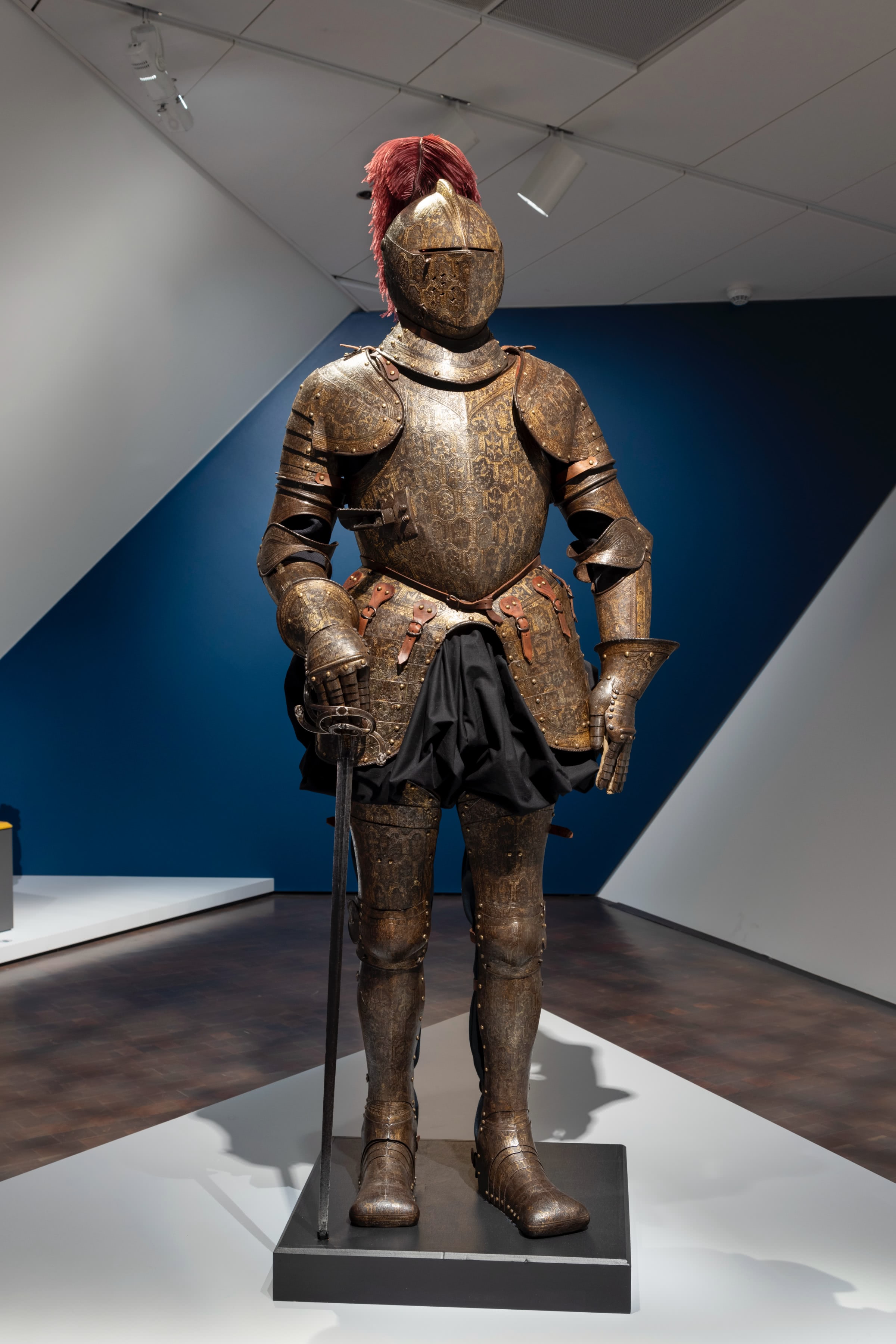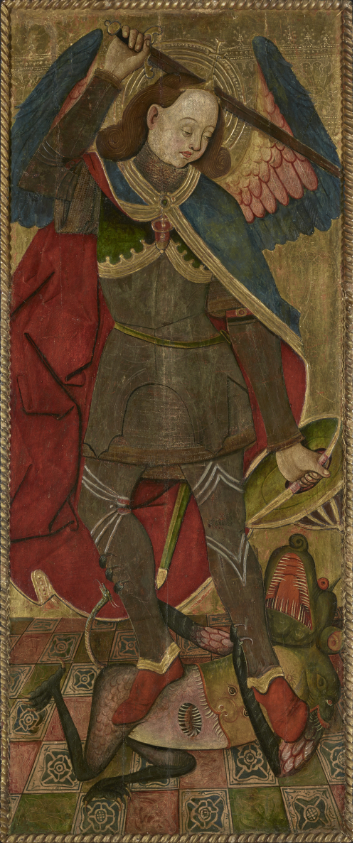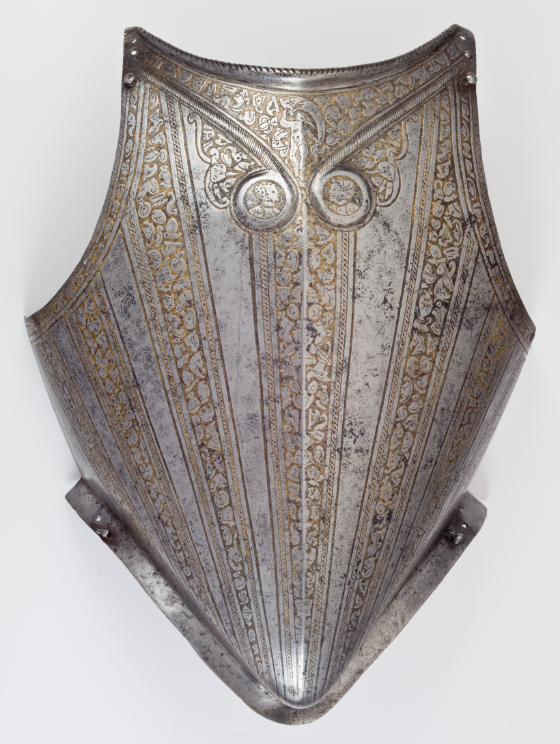Introduction
Armor and those who wore it shaped history and influenced mythological and romantic ideals. It functioned as a means of personal defense and as a canvas for fine craftsmanship. It also signaled a range of projections and expectations, from social status and moral character to ambition and nostalgia. The Age of Armor explores these uses from the Middle Ages through the Renaissance and into the modern era.
Armor adapted as technology, battlefield conditions, and fashion evolved. Even as armor’s protective function became increasingly obsolete, its forms continued to reflect social values and ideals.
The Higgins Armory Collection at the Worcester Art Museum is one of the finest collections of its kind in the United States. It features masterpieces of European arms and armor as well as outstanding examples from Asia and Africa. We also include artwork from the Denver Art Museum’s collection to reveal and enhance the stories about armor throughout its long history.
The Ideal
Many associate armor with ideas of knighthood and the code of conduct known as chivalry. Originally knights were a class of mounted warriors who owed military service to their feudal lords, and they eventually became icons of power and nobility. Medieval authors wrote about the ideal characteristics of knighthood: bravery, strength, charity, justice, and piety. Many who sought to be seen in this light utilized armor as a symbol of these attributes. Artists depicted ancient warriors, kings, saints, and angels as armor-clad heroes who became the symbolic forebears of the actual men who wore armor in battle or in tournaments.
Armor remained a powerful status symbol, even in its period of decline. During the Renaissance, the study of Classical European civilizations became popular, and armor often imitated ancient Greek and Roman forms to suggest the sophistication of the wearer and associate them with ancient glory.
A Knight in Shining Armor
Richly decorated with gold and silver imagery based on ancient Roman designs, this suit exemplifies the interwoven functions of European armor. It provided maximum protection for a heavy cavalry soldier in the 1600s and conveyed his noble status, cultural sophistication, and bravery. This suit evokes our perceptions of knightly heroes of the Middle Ages, such as King Arthur, Tristan, and Lancelot, and probably did for its original owner as well. This armor, however, was made when knighthood was historically in decline.
Pompeo della Cesa
Italian, about 1537–1610
Field Armor from a Garniture
About 1595
Steel, brass, gold, and silver with modern leather and fabric restorations
Weight 47 lb. 15 oz.
The John Woodman Higgins Armory Collection, 2014.112
Swept-Hilt Sword
England
About 1610
Steel with silver and gold inlay
Weight 2 lb. 6 oz
The John Woodman Higgins Armory Collection, 2014.337
Unknown French artist
Saint Martin and the Beggar
About 1520
Limestone
Denver Art Museum: Gift of the Samuel H. Kress Foundation, 1961.185
This sculpture depicts Saint Martin of Tours, a Christian Roman cavalry soldier who probably served in Gaul (modern-day France and Belgium) in the 300s. He cuts his cloak to give half to a beggar, an act of charity appropriate to Christian ideals of chivalry. The armor St. Martin wears is in the style of the late 1400s, more than a thousand years after the saint lived, demonstrating how artists linked Renaissance knights with saintly virtue.
Unknown artist
Saint Michael Fighting the Dragon
Spain, 1400s
Oil paint on panel
Denver Art Museum: Gift of Dr. Rene Spitz, 1960.62
The final book in the Christian Bible tells of a coming war between heaven and hell at the end of days. The faithful believe the archangel Michael will lead the armies of heaven and fight a dragon representing the Seven Deadly Sins. In this painting, Michael wields a sword and shield and wears armor from the 1400s, symbolically joining the purposes of Renaissance knights to those of the Church.
Classical References
Morion-Burgonet Helmet
Probably Augsburg, southern Germany
1585
Etched, heat-blackened, and fire-gilt steel and brass
Weight 3 lb. 10 oz.
The John Woodman Higgins Armory Collection, 2014.26
Image © 2021 Worcester Art Museum, all rights reserved
“Peasecod” Breastplate for Infantry
Northern Italy
1585–90
Etched steel with traces of heat blackening, gilding, and brass
Weight 4 lb. 8 oz.
The John Woodman Higgins Armory Collection, 2014.1133.2.1
Image © 2021 Worcester Art Museum, all rights reserved
In the 1500s, armor became a canvas for displaying a growing idealization of the classical age of ancient Greece and Rome. The stylized curved shape of this helmet reimagines ancient Roman helmets. Etched decoration on the breastplate also echoes classical Roman motifs: vertical bands are filled with trophies representing captured treasures and military equipment from a defeated enemy. These visual references demonstrate the wearer’s desire to be associated with the glories of the past.
Tapestry with Military Scenes
Flanders (Belgium)
Early 1600s
Wool and silk
Neusteter Textile Collection at the Denver Art Museum: Anonymous gift, 1974.275
This tapestry’s central image is a military scene, perhaps from the life of an ancient Roman general. The equipment worn by the various figures has been fancifully interpreted from classical art and literature. The surrounding border encloses figures representing (clockwise from upper left) Victory, Fame, War, and Peace.
Corinthian Helmet
Greek, from southern France
About 600–550 BCE
Bronze
Weight 3 lb. 10 oz.
The John Woodman Higgins Armory Collection, 2014.7
Image © 2021 Worcester Art Museum, all rights reserved
This elegant helmet dates to just before the Greek classical age and became a symbol of ancient martial valor. Renaissance knights looked back to the soldiers of this time as heroic warriors of an idealized culture. Although now green with age, this helmet originally would have been polished a bright gold color.

Age of Armor: Treasures from the Higgins Collection at the Worcester Art Museum is organized by the Worcester Art Museum. Support is provided by the donors to the Annual Fund Leadership Campaign and the residents who support the Scientific and Cultural Facilities District (SCFD). Promotional support is provided by 5280 Magazine and CBS4.







